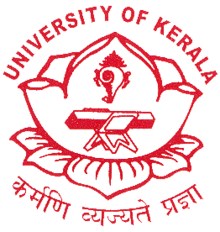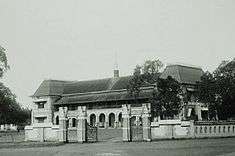University of Kerala
| കേരള സർവ്വകലാശാല | |
 | |
Former name | University of Travancore |
|---|---|
| Motto | कर्मणि व्यज्यते प्रज्ञा (Sanskrit) |
Motto in English | Karmani Vyajyate Pradnya (Wisdom manifests itself in action) |
| Type | Public |
| Established | 1937 |
| Founder | Maharajah Sree Chithira Thirunal Balarama Varma |
| Chancellor | Governor Of Kerala |
| Vice-Chancellor | Prof. P K Radhakrishnan |
| Location |
Trivandrum, Kerala, India 8°30′12″N 76°56′50″E / 8.50333°N 76.94722°ECoordinates: 8°30′12″N 76°56′50″E / 8.50333°N 76.94722°E |
| Campus | Urban |
| Affiliations | UGC |
| Website | http://www.keralauniversity.ac.in/ |

The University of Kerala (UoK), formerly the University of Travancore,[1] is an affiliating university[2] located in Thiruvananthapuram, capital of the south Indian state of Kerala, India. It was established in 1937, long before the birth of the state of Kerala in India, by a promulgation of the Maharajah of Travancore, Sri Chithira Thirunal Balarama Varma who was also the first Chancellor of the university. C. P. Ramaswami Iyer, the then Diwan (Prime Minister) of Travancore, was the first Vice-Chancellor.
History
One of the first 16 Universities in India and the first in the state of Kerala, the University of Kerala was founded as the University of Travancore in the erstwhile princely state of Travancore (now southern part of Kerala and some neighboring parts of state of Tamil Nadu) in 1937. During the 7 decades since the University of Kerala grew and shrunk physically and transformed itself in many ways.
The earliest origins of the University may be traced back to two institutions of modern learning in Kerala, the University College, Thiruvananthapuram and the Trivandrum Observatory. The University College was initially founded as the Maharaja's Free School by Maharaja Swathi Thirunal in 1834, with Mr John Roberts. A Christian Missionary as Headmaster, and soon grew into a college in 1866, affiliated to the Madras University. When the University of Travancore was founded, the Departments of the college became the University Departments, only to switch back again when the transformation to University of Kerala happened in 1957. The University College still retains its connection with the University as an affiliated college. The Trivandrum Observatory was founded in 1838 and had an internationally reputed scientist, John Caldecott FRS as its first Director. It became a part of the Travancore University, but for some time was administered as an independent government institution. It is now the oldest institution under the Kerala University.
The University of Travancore was established in 1937 by a promulgation of the Maharajah of Travancore, Sri Chithira Thirunal Balarama Varma who was also the first Chancellor of the University. Sir C. P Ramaswamy Ayyar, the then Diwan (Prime minister) of the State was the first Vice-Chancellor. He was an eminent scholar and an able administrator. It is said the Government made an unsuccessful attempt to invite Albert Einstein to be the first Vice-Chancellor. The University was modelled after the best Universities of the United Kingdom, and even today retains some of these features. The affiliating system of the University however evolved to be different from the college system in British Universities.
Only ten colleges within the State of Travancore, which were at that time affiliated to the Madras University, became the affiliated colleges of the University of Travancore. In 1954, the unified state of Kerala came into being with most of Travancore and whole of state of Cochin and Malabar area of Madras presidency becoming part of it. The Kerala University Act (Act 14 of 1957) was brought into force and the University of Travancore was renamed University of Kerala. The University had three campuses located in three different parts of the State viz. Thiruvananthapuram, Ernakulam and Kozhikode. The number of affiliated colleges grew phenomenally. However, in 1968, the University Centre at Kozhikode became a full-fledged University, the University of Calicut, affiliating the colleges located in Thrissur, Palakkad, Kozhikode and Kannur districts of Kerala and transforming the Kozhikkode Centre into University Departments. The Cochin University of Science and Technology - CUSAT -(1971), Kerala Agricultural University (1971) and Mahatma Gandhi University (1983) were subsequently established, with CUSAT taking over the University's centre at Cochin. These developments have shrunk the jurisdiction of the University of Kerala to Thiruvananthapuram, Kollam, Alappuzha Districts and some parts of Pathanamthitta District.
Departments
At present, the University has sixteen faculties and forty one departments of teaching and research in addition to study centres and other departments. Teaching, Research and Knowledge extension are the mandate of the Departments. They primarily focus on post-graduate (masters) programmes, MPhil programmes (1-year research degree) and doctoral research. In 2007, the University awarded over 100 PhDs. (University's research activities are also going on in select affiliated colleges and other recognised research centres in and outside the state). The University has had in its faculties eminent scholars who were trained under legendary figures (Sir C V Raman's student in Dept of Physics, Prof S R Ranganathan's student in Library Science and Prof Benjamin Bloom's student in Dept of Education). Some of the faculty members themselves were legends, such as famous poet K Ayyappa Panciker, Oriental scholar T Ganapathi Sasthri etc. The total number of full-time students in the University Departments is above 2000 including research students and a modest number of foreign students. The Institute of Distance Education offers a number of under-graduate and post graduate programmes which cater to more than 7000 students, all over the country and abroad.
Study Centres
The University has also a number of study centres in specialised areas such as Nano-technology, Kerala Studies, Bioinformatics, Women's Studies, Learning Difficulties, Sree Narayana Studies, Gandhian Studies etc. Some of these centres have taught programmes (Certificate/Diploma/Masters/Mphil) and many offer PhD programmes. The University has also established 10 University College of Teacher Education (UTEC) and 8 University Institute of Technologies (UIT) both of which offer under-graduate programmes (BEd in UTECs and BSc Computer Science/IT, Electronics/BBA in UITs), although masters programmes are available in select UITs. The University College of Engineering at Karyavattom offers Engineering Education at Undergraduate level. These institutions together have student strength of more than 5000.
Affiliated Colleges
The University has over 150 affiliated colleges. The role of the University is in prescribing courses of study and conducting examinations and issuing certificates. The day-to-day administration of these institutions is not under the purview of the University. However, these institutions form a major part of the University. Of these 60 are Arts and Science colleges. There are 2 Law colleges, 17 Engineering Colleges, 9 MBA/MCA Colleges, 37 Teacher Training Colleges, 4 Medical Colleges, 4 Ayurveda colleges, 2 Homeopathy Colleges, one Siddha Medical College, 3 Dental colleges, 10 Nursing Colleges, 4 Pharmacy Colleges, 2 Fine Arts Colleges, and a Music College. The University also has a National College of Physical Education affiliated to it. The total number of students in these colleges crosses 84,000.
See also
References
- ↑ "ABOUT". keralauniversity.ac.in. Retrieved 19 November 2011.
- ↑ http://www.keralauniversity.ac.in/about.htm
External links
| Wikimedia Commons has media related to University of Kerala. |
- University of Kerala Official Website
- University of Kerala, Research Portal
- University of Kerala, Computer Centre and Examination Portal
- Dr. Raja Rama Varma Rohani Thirunal, Prince of Mavelikara Palace
- Trivandrum Observatory and Caldecott
- John Caldecott from The Edinburgh New Philosophical Journal, Volume 48